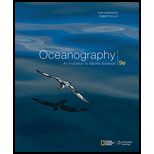
The factors that contribute to the uneven heating of the Earth by the sun.
Answer to Problem 1TC
The factors that contribute to the uneven heating of the Earth by the sun include latitude, seasons, and the time of the day.
Explanation of Solution
The heat budget of the Earth is not balanced in different latitudes even though it is balanced as a whole. The radiation from the sun that strikes the polar latitudes spreads and covers a large area than that strikes at the tropical latitudes. Adjacent to the poles, filtering of sunlight occurs through more atmosphere and they approach the surface at a low angle, and thereby allows reflection.
During the depths of local winter, no solar radiation is received at the Polar Regions. In contrast, sunlight strikes at a more nearly vertical angle at tropical latitudes and as a result, the same amount of sunlight is distributed over a much smaller area. It leads to the striking of more solar energy in tropical regions than the Polar Regions, and mid-latitude areas receive more heat in summer than in winter.
Due to the
In addition, the time of the day is also an important factor. The rotating Earth spins around the polar axis. As a result, sunrise and sunset occur daily. The sunlight in the morning and afternoon is not strong as the midday sunlight.
Want to see more full solutions like this?
Chapter 8 Solutions
Oceanography: An Invitation To Marine Science, Loose-leaf Versin
 Applications and Investigations in Earth Science ...Earth ScienceISBN:9780134746241Author:Edward J. Tarbuck, Frederick K. Lutgens, Dennis G. TasaPublisher:PEARSON
Applications and Investigations in Earth Science ...Earth ScienceISBN:9780134746241Author:Edward J. Tarbuck, Frederick K. Lutgens, Dennis G. TasaPublisher:PEARSON Exercises for Weather & Climate (9th Edition)Earth ScienceISBN:9780134041360Author:Greg CarbonePublisher:PEARSON
Exercises for Weather & Climate (9th Edition)Earth ScienceISBN:9780134041360Author:Greg CarbonePublisher:PEARSON Environmental ScienceEarth ScienceISBN:9781260153125Author:William P Cunningham Prof., Mary Ann Cunningham ProfessorPublisher:McGraw-Hill Education
Environmental ScienceEarth ScienceISBN:9781260153125Author:William P Cunningham Prof., Mary Ann Cunningham ProfessorPublisher:McGraw-Hill Education Earth Science (15th Edition)Earth ScienceISBN:9780134543536Author:Edward J. Tarbuck, Frederick K. Lutgens, Dennis G. TasaPublisher:PEARSON
Earth Science (15th Edition)Earth ScienceISBN:9780134543536Author:Edward J. Tarbuck, Frederick K. Lutgens, Dennis G. TasaPublisher:PEARSON Environmental Science (MindTap Course List)Earth ScienceISBN:9781337569613Author:G. Tyler Miller, Scott SpoolmanPublisher:Cengage Learning
Environmental Science (MindTap Course List)Earth ScienceISBN:9781337569613Author:G. Tyler Miller, Scott SpoolmanPublisher:Cengage Learning Physical GeologyEarth ScienceISBN:9781259916823Author:Plummer, Charles C., CARLSON, Diane H., Hammersley, LisaPublisher:Mcgraw-hill Education,
Physical GeologyEarth ScienceISBN:9781259916823Author:Plummer, Charles C., CARLSON, Diane H., Hammersley, LisaPublisher:Mcgraw-hill Education,





